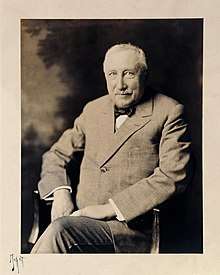Towner K. Webster
Towner Keeney Webster (1849 – 1922) was an American industrialist and business leader who started several businesses, including Webster Manufacturing and Webster Electric.
Towner Keeney Webster | |
|---|---|
 | |
| Born | July 31, 1849 Ithica, New York |
| Died | October 11, 1922 (aged 73) Evanston, Illinois |
| Occupation | Industrialist |
| Spouse | Emma Josephine Kitchell Webster (1850-1937) |
Early life
Webster was born in Ithaca, New York. His father, Dr. Henry Keeney Webster (1800–1857), died when he was eight years old. His mother, Sarah Haviland (1811–1885), was left with little money and three children to raise. By age 12, Webster had a full-time job and never achieved more than a grade school education. When he turned 18, he traveled alone to Chicago and began work at a dry goods store. Within a year or two, his mother and two older sisters followed. All settled in Evanston, Illinois. Webster’s first business, a drug and grocery store on Davis Street in Evanston, was a success. He sold his interest in the grocery to his partner, so he could start a clothing store. The clothing stored failed.[1] Shortly thereafter, in 1874, he married Emma Josephine Kitchell (1850–1937).[2] Webster needed to find a new way to make a living.
Webster Manufacturing
Webster became intrigued with an invention called the “Common-sense" elevator bucket.”[3] These buckets were easily manufactured, and when attached to a continuous belt could carry large amounts of grain to the tops of grain elevators. Thanks to developments like Cyrus McCormick’s reaper, elevators were springing up all over the Midwest. In 1876, he began making common-sense buckets in a small shop on Kinzie Street in Chicago. His company grew quickly as he developed machinery for handling grain. He acquired partners and built his first factory in 1882. It doubled and then redoubled in size, and in 1889 Webster moved to a new plant on Western Avenue and Fifteenth Street. His partners dropped out, the firm became the Webster Manufacturing Company.[4]
In the early 1890s a group of investors, one of whom was Mark Twain, gave Webster Manufacturing the contract to make the Paige Compositor. The device, which set type, was a complicated mechanical marvel with 18,000 parts. Webster built a new five story building at the Western Avenue plant to deliver 3000 compositors under the contract. Unfortunately, the compositor was expensive to manufacture and when it broke down only the inventor’s chief engineer, Charles Davis, could fix it. The rival linotype machine soon came to dominate the typesetting market. What had seemed like a profitable business venture, cost Mark Twain a fortune and almost bankrupt Webster Manufacturing. Fewer than half-a-dozen machines were actually built.[1] The sole remaining Paige compositor is housed at the Mark Twain House and Museum in Hartford, Connecticut.
In 1897, Webster, having returned to his core business, build a two-million-bushel grain elevator on the newly opened Manchester Ship Canal in England. In 1907, Webster moved his firm to Tiffin, Ohio where it exists today as Webster Industries. To finance the move to Tiffin, Webster took on outside investors. Dissatisfied with company profits and Webster’s management style, they assumed control of the company.[1]
Webster Electric
During his tenure in Tiffin, Webster became interested in a new invention, the Milton magneto. The magneto could start gasoline engines without cranking. After refining the device into what he thought to be a workable ignition system, Webster signed a contract with the Cadillac Automobile company which intended to make it standard on their cars. But the magneto proved to be unreliable and the contract was canceled. Webster’s son, Towner K. Webster Jr., was an engineer who eventually perfected the magneto as an ignition system for farm engines. In 1914, Webster Sr. opened a new company in Racine, Wisconsin named Webster Electric.[5]
The magneto was a profitable product, but it was gradually supplanted by other ignition systems. After Webster’s death, the company struggled until the 1930s, when it introduced a popular intercom called the Teletalk. Then, in 1946, Webster Electric debuted the Ekotape recorder, and was for a time a pioneer in magnetic recording. The company was eventually sold to Sta-Rite Industries.[6]
Towner K. Webster died October 11, 1922 in Evanston, Illinois. He was survived by his wife Emma Josephine and six children.
Notable descendants
- Henry Kitchell Webster (1875-1932) - Novelist
- Josephine Webster Strong (1883-1961) - Married Walter A. Strong, Publisher Chicago Daily News
- Maurice Webster (1892-1982) - Architect
- Stokely Webster (1912-2001) - Artist
- Jonathan Strong (1944-present) - Novelist
- James G. Webster (1951-present) - Professor
References
- Webster, Henry K. (1930). A Memoir of Towner Keeney Webster. Chicago: Walter A. Strong.
- Webster, Stokely (2001). Stokely Webster and his Paris. Hartford, CN: Connecticut River Press. p. 19. ISBN 0-9706573-0-7.
- "History". Webster Industries. Retrieved 5 April 2020.
- Marquis, Albert (1911). The Book of Chicagoans: A Biographical Dictionary of Leading Living Men of the City of Chicago.
- Hunolt, Greg (September 2014). "Webster Electric of Racine" (PDF). WARI News. Retrieved 5 April 2020.
- Minton, R. "Webster electric developed the intercom, other sound recording equipment" (2001 October 22). The Journal Times.